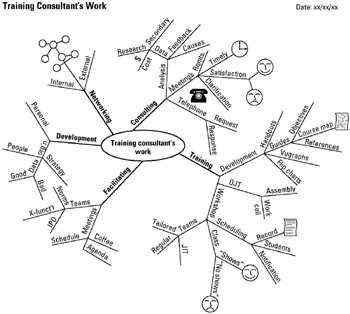Tool 110: Mind Flow
| AKA | Brain Webs |
| Classification | Idea Generating (IG) |
Tool description
The mind flow technique produces a simple diagram of a team member's interconnecting brain activities, thereby enhancing the team's creativity and quality of thought when the resulting information is compared and added to from other diagrams. The result is a nonlinear approach to thinking—a mind flow diagram that reflects the creative generation of ideas, opens up new insights into problematic conditions or maps new possibilities for improving existing processes.
| Note | More advanced Mind Mapping™ techniques were first introduced by Tony Buzan (1974). Buzan advocates Mind Mapping™ for note taking, creative writing, and problem-solving. |
Typical application
-
To map complex situations by acquiring, collating, and connecting thoughts and data to a central topic on problem statement.
-
To creatively identify requirements and connect details to main issues.
-
To stimulate a team to surface new ideas in a problem-solving effort.
-
To clarify links between ideas and processes and reflect relevant elements of major activities.
Problem-solving phase
| → | Select and define problem or opportunity |
| → | Identify and analyze causes or potential change |
| Develop and plan possible solutions or change | |
| Implement and evaluate solution or change | |
| Measure and report solution or change results | |
| Recognize and reward team efforts |
Typically used by
| Research/statistics | |
| 1 | Creativity/innovation |
| 3 | Engineering |
| Project management | |
| Manufacturing | |
| Marketing/sales | |
| Administration/documentation | |
| Servicing/support | |
| Customer/quality metrics | |
| 2 | Change management |
before
-
Brainstorming
-
Idea Borrowing
-
Audience Analysis
-
Fresh Eye
-
Circles of knowledge
after
-
Futures Wheel
-
Starbursting
-
Cluster Analysis
-
Problem Analysis
-
Cause and Effect Diagram (CED)
Notes and key points
-
Use symbols or images when appropriate. See example:

Step-by-step procedure
-
STEP 1 The team seeks an experienced facilitator for the mind flow process. Then the facilitator assists in setting up the mind flow exercise for the team.
-
STEP 2 A conference room with a whiteboard must be scheduled. A whiteboard works better than flip charts because it is easier to revise information during the session. Also, a set of color markers should be obtained.
-
STEP 3 At the beginning of the session, the facilitator explains the basic mind flow process. Drawing brief sketches on the whiteboard will assist in the understanding of connecting, clustering, coding, and mapping the information.
-
STEP 4 One team participant should volunteer to copy the mind flow diagram from the whiteboard as the team develops and records the information.
-
STEP 5 The team brainstorms or refers to an idea or problem to be used in the mind flow process. See example Training Consultant's Work.
-
STEP 6 A circle is drawn on the whiteboard and initial responses (key branches) are connected to the center.
-
STEP 7 The team continues to add information to the key branches in greater detail, creating more branches with yet greater detail as shown in the example.
-
STEP 8 Once the mind flow diagram is completed, a final check is performed and the diagram is dated.
Example of tool application

EAN: 2147483647
Pages: 326
- Article 354 Nonmetallic Underground Conduit with Conductors Type NUCC
- Article 424: Fixed Electric Space Heating Equipment
- Article 500 Hazardous (Classified) Locations, Classes I, II, and III, Divisions 1 and 2
- Example No. D2(a) Optional Calculation for One-Family Dwelling Heating Larger than Air Conditioning [See Section 220.82]
- Example No. D4(a) Multifamily Dwelling